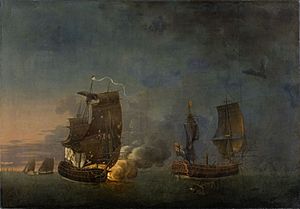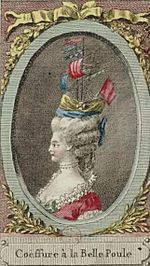Action of 17 June 1778 facts for kids
Quick facts for kids Action of 17 June 1778 |
|||||||
|---|---|---|---|---|---|---|---|
| Part of the American Revolutionary War | |||||||
 Combat de la Belle Poule et de l'Aréthusa by Auguste-Louis de Rossel de Cercy |
|||||||
|
|||||||
| Belligerents | |||||||
| Commanders and leaders | |||||||
| Strength | |||||||
|
|||||||
| Casualties and losses | |||||||
|
|
||||||
The Action of 17 June 1778 was a small but important sea battle. It happened off the coast of France. British and French ships, mainly frigates (fast warships), fought each other. This fight was also called the Fight of Belle Poule and Arethusa after two of the main ships involved. Both France and Great Britain celebrated this battle. It was the very first clash between their navies during the American Revolutionary War. This happened even before they officially declared war on each other!
Contents
Why the Battle Happened
On June 13, 1778, Admiral Augustus Keppel led a large British fleet. He had 21 ships of the line (large warships) and three frigates. The British Admiralty (the British navy's command) sent him to watch the French fleet. This French fleet was docked at Brest.
Admiral Keppel's job was to stop the Brest fleet from joining another French fleet. This other fleet was at Toulon. He was supposed to do this peacefully if possible. At this time, Britain and France were not officially at war.
French Ships Spotted
On June 17, a French group of ships was on a reconnaissance mission. This means they were scouting to gather information. The group included the 26-gun frigate Belle Poule. Also with her were the 26-gun frigate Licorne, the corvette Hirondelle, and the cutter Coureur.
They suddenly met a large British fleet. This British fleet included the ship HMS Arethusa. This meeting happened about 23 miles (37 km) south of The Lizard, a point on the coast of England.
Admiral Keppel, leading the British fleet, gave an order. He wanted the French ships to be chased. He wanted them brought back to his flagship (his main command ship). He did not want the French to see how strong his British fleet was.
The Battle Begins
The French ship Licorne followed the order at first. Two British ships, HMS Milford (with 28 guns) and HMS America (with 64 guns), caught up to her.
Licorne then tried to escape during the night. But she was caught again. After a short fight with America, a ship much larger than her, Licorne surrendered.
Meanwhile, the British ship Arethusa and the cutter HMS Alert chased Belle Poule. The French cutter Le Courier was with Belle Poule. The captain of Belle Poule refused to sail back to the British fleet.
A Fierce Fight
The British fired a warning shot across the Belle Poule's bow (front of the ship). The French captain responded with a full broadside. This means he fired all the cannons on one side of his ship at once.
A fierce, two-hour battle began between Arethusa and Belle Poule. Belle Poule wanted to escape. She started to cause serious damage to Arethusa. Arethusa's topmasts (upper parts of the masts) were hanging over the side. Her sails were torn. Soon after, Arethusa was badly damaged and lost her main mast.
The wind then died down. This made the shot-torn sails of Belle Poule fall. However, she still had enough wind to drift away. She moved out of reach of Arethusa's cannons. Both ships were close to the French cliffs. Belle Poule managed to get into a small cove (a small bay) in the rocks.
Arethusa had to cut away her broken parts. She then put up whatever sails she could. She slowly made her way back to the British fleet using jury-masts (temporary masts).
At the same time, the French cutter Coureur was caught by the British cutter Alert. After some fighting, Coureur was taken to Admiral Keppel's flagship. The French ship Hirondelle managed to escape the battle completely.
After the Battle
Arethusa had 44 crew members injured or killed out of 198. Her masts and rigging were so badly damaged that other British ships had to tow her. As more ships from Keppel's fleet arrived, Belle Poule sailed away towards the French coast. She had lost 30 crew members killed and 72 wounded. Her captain, Lieutenant Jean Isaac Chadeau de la Clocheterie, was among the wounded.
This battle was the first fight between British and French navies. It happened during the Anglo-French War 1778 (a part of the American Revolutionary War). It took place about three weeks before France officially declared war. Admiral Keppel was surprised by the French captains' actions. He had only intended to talk to them and then let their ships go.
Celebrations and Songs
The battle was celebrated as a victory in France. Ladies in high society even created a new hairstyle called "Belle Poule". It featured a small ship on top of the head!
In Britain, the capture of Licorne and Coureur was also seen as a victory. The battle became the subject of a traditional Sea shanty (a sailor's song) called The Saucy Arethusa.
The ship Arethusa is also mentioned in a song. This song is on the album Her Majesty the Decemberists by the band the Decemberists.
Images for kids





